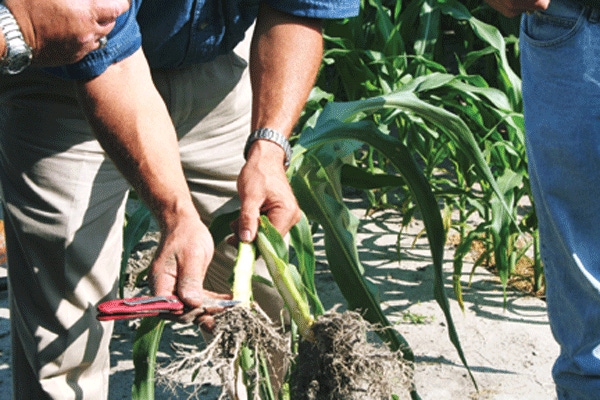
• The handful of fields with damaging levels of WCRW in Georgia have all been on farms with cattle or dairy operations where corn is being grown continuously for grain or silage.• An integrated approach with rotation of crops and insecticides, including Bt toxins, will help to prevent the development of resistance by target pests.
January 13, 2012

You may have seen reports earlier this year that resistance to Bt corn by field populations of the western corn rootworm (WCRW) has been confirmed in Iowa.
(For the earlier reports of resistance in the Midwest, see http://southeastfarmpress.com/grains/severe-root-damage-bt-corn-confirmed-illinois and http://southeastfarmpress.com/grains/new-instances-severe-rootworm-damage-bt-corn-reported.
WCRW is sometimes called the billion dollar pest because of the extent of damage it causes to corn and cost of its control.
In 2003 Monsanto introduced the first Bt toxin, Cry3Bb1, with activity against mid-season rootworms. Two other Bt toxins targeting mid-season rootworms, mCry3A from Syngenta and Cry34/35Ab1 from Dow Agroscience, have also been introduced since then.
All these products have been effective at preventing rootworm damage across the Corn Belt. It should be noted that these Bt rootworm traits are not effective against the southern corn rootworm, which is a common pest of several crops in the Southeast.
Field observations of greater than expected root injury by WCRW to Bt corn with the Cry3Bb1 toxin have been reported in the last several years. A team led by Aaron J. Gassmann of Iowa State University has demonstrated the development of resistance to the Cry3Bb1 toxin by a field population of western corn rootworms in northeastern Iowa.
The journal article, “Field-Evolved Resistance to Bt Maize by Western Corn Rootworm,” was published July 29 in PLoS ONE (www.plosone.org; Vol. 6, Issue 7, pp 1-7).
First evidence of resistance
This is the first report to document field-evolved resistance by WCRW to a Bt toxin. The paper documents decreased susceptibility to the Cry3Bb1 protein in the progeny whose rootworm beetles had been collected in cornfields that had significant larval injury to corn roots.
A common characteristic of all the fields with resistance was that Bt hybrids expressing the Cry3Bb1 protein had been used for 3 or more consecutive years in these fields.
Late last summer unexpected root damage also was reported from Bt corn fields in southern Minnesota and northwest Illinois (see report by Mike Gray, Univ. of Illinois, http://bulletin.ipm.illinois.edu/article.php?id=1555). However, the cause of WCRW damage in these fields has yet to be determined.
What does this mean for corn producers in Georgia?
The western corn rootworm has been spreading eastward and southward for decades and first found damaging corn in northwest Georgia about 1990. It is now present in the northern two-thirds of the state.
WCRW has only one main host, corn. It has one generation per year and over-winters in the egg stage in the soil. Female beetles are attracted to silking corn and lay eggs in the soil.
If corn is planted in the same field the following year, larvae attack the corn roots. All but a small percentage of the corn grown in Georgia is rotated with other non-host crops which effectively prevents WCRW damage.
The handful of fields I have seen with damaging levels of WCRW in Georgia have all been on farms with cattle or dairy operations where corn is being grown continuously for grain or silage.
In a few cases where crop rotation was not an option, hybrids with a Bt rootworm trait have been very effective in controlling these infestations.
Soil applied insecticides or the use of Poncho 1250 seed treatment are other useful control measured. Therefore, reduced susceptibility by WCRW to Bt corn should not be an issue that directly affects most corn producers in Georgia.
Nevertheless this is an example of importance of not relying on the repeated use a single method and insecticide for pest control. Instead an integrated approach with rotation of crops and insecticides, including Bt toxins, will help to prevent the development of resistance by target pests.
You May Also Like



